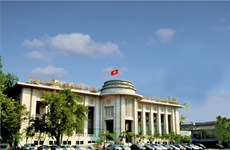Financial sector prioritises macroeconomic stability
The financial sector will in 2012 give priority to curbing inflation,
ensuring macro-economic stability and maintaining an appropriate growth
rate in combination with renewing the growth model and restructuring the
national economy.
The financial sector will in 2012 give priority to curbing inflation,
ensuring macro-economic stability and maintaining an appropriate growth
rate in combination with renewing the growth model and restructuring the
national economy.
The 2012 plan was presented by Finance Minister Vuong Dinh Hue at a conference in Hanoi on Dec. 24 to initiate financial-banking tasks for 2012.
The Minister said thrift practice must continue and spending cut needs to be implemented more effectively to bring budget overspending down to less than 4.8 percent of the country’s GDP.
Next year, market-ruled pricing mechanism needs to follow the set roadmap so a pricing system running basically in line with market principles under the State management will probably run by 2015, Hue said.
He noted that the Finance Ministry will pursue the implementation of market price principles in the year, particularly for electricity, coal, petroleum and public services.
It will coordinate with relevant ministries and agencies to complete management mechanisms for electricity and petroleum and price stability, Hue said.
Accordingly, the Ministry will work closely with the Government Inspectorate and the State Audit to keep a close eye on sensitive commodities such as electricity and coal to make their operations more transparent.
In the year, the Minister stressed that fiscal policy should be coordinated with monetary policy and other policies to well curb inflation and maintain macroeconomic stability, thus boosting socio-economic development.
Attention will be also given to working out financial, banking and monetary solutions to support businesses.
The Finance Ministry has set to work with the Ministry of Planning and Investment to implement a plan on economic restructuring, targeting State-owned enterprises (SOE), public investments in State budget-used areas and development investment credits, government bonds and public investment in economic groups and State corporation, with the aim of basically completing the process of SOE equitisation by 2015.
Addressing the event, Deputy Prime Minister Vu Van Ninh stressed that the sector should continue completing financial and budgetary mechanisms towards mobilising every resource and at the same time supplementing and amending the tax system to support businesses.
In 2011, the financial sector’s budget collection surpassed its yearly estimation by 13.4 percent and increased 20.6 percent over last year. Budget overspendings accounted for 4.9 percent of GDP, 0.4 percent lower than the estimated level.
By December 31, public debts, government debts, and national debts are estimated to account for 54.6 percent, 43.6 percent and 41.5 percent of GDP, respectively, which are well within the safety limits./.
The 2012 plan was presented by Finance Minister Vuong Dinh Hue at a conference in Hanoi on Dec. 24 to initiate financial-banking tasks for 2012.
The Minister said thrift practice must continue and spending cut needs to be implemented more effectively to bring budget overspending down to less than 4.8 percent of the country’s GDP.
Next year, market-ruled pricing mechanism needs to follow the set roadmap so a pricing system running basically in line with market principles under the State management will probably run by 2015, Hue said.
He noted that the Finance Ministry will pursue the implementation of market price principles in the year, particularly for electricity, coal, petroleum and public services.
It will coordinate with relevant ministries and agencies to complete management mechanisms for electricity and petroleum and price stability, Hue said.
Accordingly, the Ministry will work closely with the Government Inspectorate and the State Audit to keep a close eye on sensitive commodities such as electricity and coal to make their operations more transparent.
In the year, the Minister stressed that fiscal policy should be coordinated with monetary policy and other policies to well curb inflation and maintain macroeconomic stability, thus boosting socio-economic development.
Attention will be also given to working out financial, banking and monetary solutions to support businesses.
The Finance Ministry has set to work with the Ministry of Planning and Investment to implement a plan on economic restructuring, targeting State-owned enterprises (SOE), public investments in State budget-used areas and development investment credits, government bonds and public investment in economic groups and State corporation, with the aim of basically completing the process of SOE equitisation by 2015.
Addressing the event, Deputy Prime Minister Vu Van Ninh stressed that the sector should continue completing financial and budgetary mechanisms towards mobilising every resource and at the same time supplementing and amending the tax system to support businesses.
In 2011, the financial sector’s budget collection surpassed its yearly estimation by 13.4 percent and increased 20.6 percent over last year. Budget overspendings accounted for 4.9 percent of GDP, 0.4 percent lower than the estimated level.
By December 31, public debts, government debts, and national debts are estimated to account for 54.6 percent, 43.6 percent and 41.5 percent of GDP, respectively, which are well within the safety limits./.













